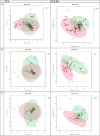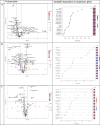Metabolomics analysis of children with spastic cerebral palsy: a case-control study
- PMID: 40596988
- PMCID: PMC12220464
- DOI: 10.1186/s12887-025-05828-w
Metabolomics analysis of children with spastic cerebral palsy: a case-control study
Abstract
Background: Spasticity, pain, fatigue and other secondary consequences of spastic CP may lead to metabolic alterations. The aim of this study was to analyze the plasma metabolomic profiles of children with spastic CP and compare these with typically developing controls.
Methods: This case-control study (n = 50 for CP and n = 55 for control) was conducted between September 2020 and November 2020 at Mersin University Hospital. Three to ten year old patients with spastic CP and age- and sex-matched typically developing controls were included in the study. Data on anthropometric measurements and clinical profiles were collected. Plasma samples were obtained for non-targeted metabolomics. The GC-MS based metabolomics analysis was performed. Metaboanalyst software was used for multivariate analyses, principal component analysis and pathway analyses.
Results: Spastic quadriplegia, spastic diplegia and spastic hemiplegia were found in 26 (52%), 14 (28%) and 10 (20%) patients, respectively, and 31 patients (62%) were non-ambulant. Twenty-two patients (44%) had epilepsy and antiepileptic use. Mean weight-for-age, height-for- age, and body mass index z-scores were significantly lower in the CP group (p < 0.05). Total 224 metabolites were detected in all subjects. Of these metabolites, 14 were detected at higher and 37 at lower levels in the CP group compared to the control group. The most significant changes in the CP group were found in aminoacyl-tRNA biosynthesis, tyrosine metabolism, valine, leucine and isoleucine biosynthesis, alanine, aspartate and glutamate metabolism, arginine and proline metabolism, citrate cycle (TCA cycle), galactose metabolism and glutathione metabolism. Forty-five metabolites were statistically significant between control, CP with epilepsy and CP without epilepsy groups. Thirty-four metabolites were statistically significant between control, ambulant CP and non-ambulant CP groups.
Conclusion: Plasma of spastic CP children was associated with alterations in energy metabolism and protein synthesis and amino acid metabolism compared to typically developing children. Gross motor functional level and accompanying epilepsy may also alter the metabolite profiles.
Keywords: Cerebral palsy; Children; Non-targeted metabolomics; Plasma metabolomics.
© 2025. The Author(s).
Conflict of interest statement
Declarations. Ethics approval and consent to participate: This study was performed in accordance with the Declaration of Helsinki. The local ethics committee; Mersin Universıty Clinical Research Ethics Committee (MEU2020/312) approved the study protocol. The parents of all included children were given consent to participate. All included typically developing children and children with CP who are able gave verbal assent. Consent for publication: Not applicable. Competing interests: The authors declare no competing interests.
Figures



Similar articles
-
Exercise interventions for cerebral palsy.Cochrane Database Syst Rev. 2017 Jun 11;6(6):CD011660. doi: 10.1002/14651858.CD011660.pub2. Cochrane Database Syst Rev. 2017. PMID: 28602046 Free PMC article.
-
The relationship between functional status and hematological parameters in children with spastic cerebral palsy: a retrospective cross-sectional study.Transl Pediatr. 2025 Jun 27;14(6):1087-1102. doi: 10.21037/tp-2024-564. Epub 2025 Jun 18. Transl Pediatr. 2025. PMID: 40688203 Free PMC article.
-
Botulinum toxin type A in the treatment of lower limb spasticity in cerebral palsy.Cochrane Database Syst Rev. 2000;(2):CD001408. doi: 10.1002/14651858.CD001408. Cochrane Database Syst Rev. 2000. PMID: 10796784
-
Surgical treatment for the thumb-in-palm deformity in patients with cerebral palsy.Cochrane Database Syst Rev. 2005 Oct 19;2005(4):CD004093. doi: 10.1002/14651858.CD004093.pub2. Cochrane Database Syst Rev. 2005. PMID: 16235349 Free PMC article.
-
Treadmill interventions with partial body weight support in children under six years of age at risk of neuromotor delay.Cochrane Database Syst Rev. 2011 Dec 7;(12):CD009242. doi: 10.1002/14651858.CD009242.pub2. Cochrane Database Syst Rev. 2011. Update in: Cochrane Database Syst Rev. 2017 Jul 29;7:CD009242. doi: 10.1002/14651858.CD009242.pub3. PMID: 22161449 Updated.
References
-
- Upadhyay J, Tiwari N, Ansari MN. Cerebral palsy: Aetiology, pathophysiology and therapeutic interventions. Clin Exp Pharmacol Physiol. 2020;47(12):1891–901. - PubMed
-
- Tezol Ö, Yalçin SS, Yirün A, Balci Özyurt A, Okuyaz Ç, Erkekoğlu P. Plasma bisphenol a and phthalate levels in children with cerebral palsy: a case-control study. Int J Environ Health Res. 2024;34(1):499-513. - PubMed
-
- Hollung SJ, Vik T, Lydersen S, Bakken IJ, Andersen GL. Decreasing prevalence and severity of cerebral palsy in Norway among children born 1999 to 2010 concomitant with improvements in perinatal health. Eur J Paediatr Neurol. 2018;22(5):814–21. - PubMed
MeSH terms
Substances
Grants and funding
LinkOut - more resources
Full Text Sources
Medical
Miscellaneous

